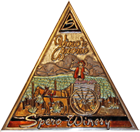The Infinite Monkey Theorem
by
Terry Sullivan
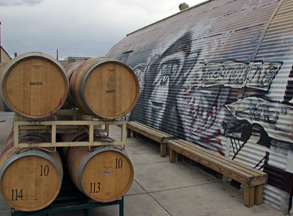 Summary: Based on a probability theorem, the name of the Infinite Monkey Theorem is catchy and the wines are enjoying a cult-like following in Denver. Ben Parsons, winemaker, enjoys concentrating on making wine in downtown Denver. He sees the process as one that makes “order out of chaos.”
Summary: Based on a probability theorem, the name of the Infinite Monkey Theorem is catchy and the wines are enjoying a cult-like following in Denver. Ben Parsons, winemaker, enjoys concentrating on making wine in downtown Denver. He sees the process as one that makes “order out of chaos.”
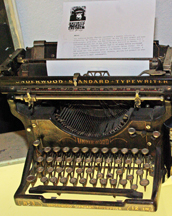 The unique name for the winery does have a connection to wine. The Infinite Monkey Theorem Winery is named after a probability theorem that states that given a typewriter and an infinite amount of time, a monkey will type the complete works of Shakespeare. Chances of that happening are remote in a given lifetime. When one thinks about winemaking, chances are also remote that two different winemakers using the same varietal grapes from the same vineyard in the same row would craft a wine that is exactly the same. There are so many decisions that winemakers make that the probability that two wines would be the same is as remote as a monkey typing the complete works of Shakespeare.
The unique name for the winery does have a connection to wine. The Infinite Monkey Theorem Winery is named after a probability theorem that states that given a typewriter and an infinite amount of time, a monkey will type the complete works of Shakespeare. Chances of that happening are remote in a given lifetime. When one thinks about winemaking, chances are also remote that two different winemakers using the same varietal grapes from the same vineyard in the same row would craft a wine that is exactly the same. There are so many decisions that winemakers make that the probability that two wines would be the same is as remote as a monkey typing the complete works of Shakespeare.
Ben wanted to concentrate on the winemaking variables that mattered the most and not dwell on variables that did not affect the wine in the bottle. So the quality of the grapes matter more than the wine region where the vineyard is located. The quality of the wine in the bottle matters more than the tasting room counter top. Ben works closely with a few Colorado vineyard owners. He monitors the grapes during the growing season and makes decisions based on the grapes’ quality.
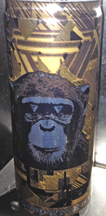 In additional to using the standard 750 ml bottles for wines, The Infinite Monkey Theorem Winery also has two wines in 250 ml cans and wine is also available in kegs. The kegs are for restaurants. The wine will remain fresh for 120 days. Restaurants are always faced with a challenge of opening a bottle of wine and serving one glass of it. The remaining wine in the bottle does not last long. The keg idea should greatly reduce the wine that has to be thrown out. The wine in cans is a perfect idea for many situations where bottles and cork screws are not practical. Stadiums, airplanes, outdoor events, hikers are just a few that would profit from wine in the cans.
In additional to using the standard 750 ml bottles for wines, The Infinite Monkey Theorem Winery also has two wines in 250 ml cans and wine is also available in kegs. The kegs are for restaurants. The wine will remain fresh for 120 days. Restaurants are always faced with a challenge of opening a bottle of wine and serving one glass of it. The remaining wine in the bottle does not last long. The keg idea should greatly reduce the wine that has to be thrown out. The wine in cans is a perfect idea for many situations where bottles and cork screws are not practical. Stadiums, airplanes, outdoor events, hikers are just a few that would profit from wine in the cans.
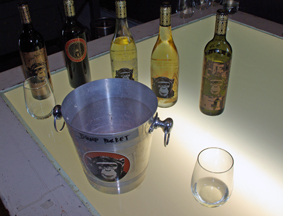 The images of monkeys and the symbol for probability are evident in the tasting room. Back lit architectural tables are used to taste wines rather than a traditional tasting counter. On the table there is an old typewriter that conjures images of monkeys hammering out keys.The back lit table makes it easy to identify a wine’s color. We tasted several wines with Ben on the day of our visit.
The images of monkeys and the symbol for probability are evident in the tasting room. Back lit architectural tables are used to taste wines rather than a traditional tasting counter. On the table there is an old typewriter that conjures images of monkeys hammering out keys.The back lit table makes it easy to identify a wine’s color. We tasted several wines with Ben on the day of our visit.
Wines
The Sauvignon Blanc was a blend of mostly Sauvignon Blanc and a little Semillon. The grapes were cofermented in stainless steel tanks. The light straw color wine had citrus and tropical fruits on the aroma and taste. The finish was crisp with a moderate fruity aftertaste. The 2010 Chardonnay was made with fruit from the Palisade area of the western slope of Colorado. The straw color wine was fruit forward with hints of apples, pears and citrus.
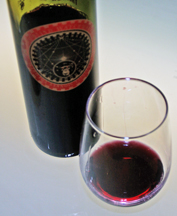 The Blind Watchmaker is a blend that changes from year to year. The blend we tasted was made from two vintages of Petit Verdot. Dark fruits on the aroma and taste had bold tannins on the long fruity finish. The 2010 Petite Sirah, made with fruit sourced from the Palisade area was a dark ruby color. The wine was very fruit forward with different black fruits. There were bold tannins on the fruity finish that had a long aftertaste. The 100th Monkey was a blend of Petit Verdot, Syrah, Cabernet Franc and Petite Sirah. The wine was aged 22 months in French oak. The wine was a dark ruby color and offered dark fruit on the aroma and taste. There were hints of spice on the finish that had bold tannins.
The Blind Watchmaker is a blend that changes from year to year. The blend we tasted was made from two vintages of Petit Verdot. Dark fruits on the aroma and taste had bold tannins on the long fruity finish. The 2010 Petite Sirah, made with fruit sourced from the Palisade area was a dark ruby color. The wine was very fruit forward with different black fruits. There were bold tannins on the fruity finish that had a long aftertaste. The 100th Monkey was a blend of Petit Verdot, Syrah, Cabernet Franc and Petite Sirah. The wine was aged 22 months in French oak. The wine was a dark ruby color and offered dark fruit on the aroma and taste. There were hints of spice on the finish that had bold tannins.
One of the wines in a can is a Black Muscat. The canned wines are slightly effervescent. The Black Muscat was clear with a reddish hue. The aroma was floral and the taste reminded me of orange blossoms. The wine was fresh and cleansing. One can see that this wine would be perfect at sporting events and other venues where carrying a bottle is not practical.
In the short time that the Infinite Monkey Theorem has been open, it has been successful. Their wines are in over 200 restaurants in the Denver area and perhaps people will begin to see them in New York City restaurants in the future. There is a growing following for their wines that are well balanced and easily drinkable. The winery has outgrown its present size and is in the process of relocating to a larger urban facility.
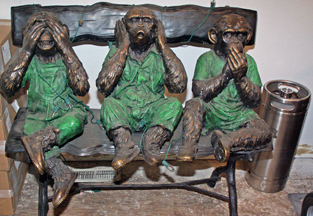 Visit the Infinite Monkey Theorem and have their wines in restaurants. Take a moment to study the bottle labels. They are very interesting.
Visit the Infinite Monkey Theorem and have their wines in restaurants. Take a moment to study the bottle labels. They are very interesting.
The Infinite Monkey Theorem
931 W 5th Ave
Denver, Colorado
GPS: 39º 43.453 W104º 59.951’
Watch for their future location at:
3200 Larimer
Denver, Colorado 80205
Visit this Colorado lodging facility that partners with Wine Trail Traveler.
Spero Winery |
Wine Country Inn |
||
